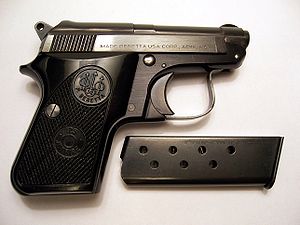
A machine pistol is an autoloading pistol capable of fully automatic fire, including stockless handgun-style submachine guns.

The Beretta Cheetah, also known by its original model name of "Series 81", or "80 Series", is a line of compact blowback operated semi-automatic pistols designed and manufactured by Beretta of Italy. They were introduced in 1976 and include models in .32 ACP, .380 ACP and .22 LR. Production paused in 2017, but Beretta revived the marque in 2023 with the release of the 80X.

The Beretta 21A Bobcat is a semi-automatic pocket pistol designed by Beretta in Italy. Production began in the late 1984, solely in the Beretta U.S.A. facility in Accokeek, Maryland. It is a further development of the Beretta Model 20, whose production ended in 1985.
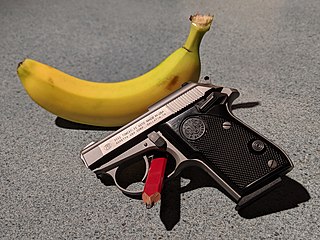
The Beretta 3032 Tomcat and Beretta 3032 Tomcat Inox are semi-automatic pocket pistols designed and manufactured by Beretta. They are chambered in .32 ACP and are small pistols, designed for concealed-carry and use as backup weapons. The Beretta 3032 Tomcat builds on a long line of small and compact pocket pistols for self defense manufactured by Beretta. The allure and popularity is commonly attributed to the loading procedure, which does not require the user to "rack" the slide to chamber a round, but rather place a round in the tip-up barrel before the magazine is inserted. This is especially popular for those with weaker or smaller hands.
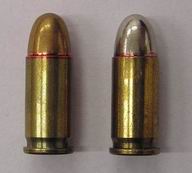
.32 ACP is a centerfire pistol cartridge. It is a semi-rimmed, straight-walled cartridge developed by firearms designer John Browning, initially for use in the FN M1900 semi-automatic pistol. It was introduced in 1899 by Fabrique Nationale, and is also known as the 7.65 mm Browning Short.

The Thunder 380 is a lightweight, relatively small semi-automatic pistol series chambered in the .380 ACP caliber made by Argentine firearms manufacturer Bersa, S.A.

The Heckler & KochP7 is a German 9×19mm semi-automatic pistol designed by Helmut Weldle and produced from 1979 to 2008 by Heckler & Koch GmbH (H&K). The P7M13, a variant of the P7 with a double-stack magazine, was produced until 2000.

L. W. Seecamp Co. was an American manufacturer of pocket pistols located in Milford, Connecticut from 1981 to 2014. In 2014, Whalley Precision purchased the company and took over production of the pistols from their facility in Southwick, Massachusetts.

The AMT Hardballer is a series of pistols that are part of the 1911 platform made by Arcadia Machine & Tool (AMT) from 1977 to 2002. The Hardballer was the first entirely stainless steel 1911 pattern pistol. Other features included adjustable rear sights and a lengthened grip safety.
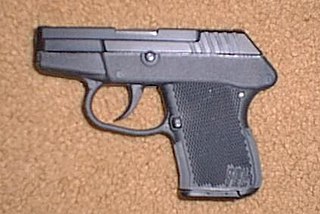
The Kel-Tec P32 is a sub-compact semi-automatic pistol using the short-recoil principle of operation that is chambered in .32 ACP. It was designed by George Kellgren. It is manufactured by Kel-Tec CNC Industries Inc., of Cocoa, Florida and was designed for concealed carry by citizens and by law enforcement officers as a back-up gun.

In American English, a pocket pistol is any small, pocket-sized semi-automatic pistol, and is suitable for concealed carry in a pocket or a similar small space.

The Colt Model 1903 Pocket Hammerless is a .32 ACP caliber, self-loading, semi-automatic pistol designed by John Browning and built by Colt Patent Firearms Manufacturing Company of Hartford, Connecticut. The Colt Model 1908 Pocket Hammerless is a variant introduced five years later in .380 ACP caliber. Despite the title "hammerless", the Model 1903 does have a hammer. The hammer is covered and hidden from view under the rear of the slide, this allows the pistol to be carried in and withdrawn from a pocket quickly and smoothly without snagging.
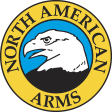
North American Arms is a United States company, headquartered in Provo, Utah, that manufactures pocket pistols and mini-revolvers, also called mouse guns. The company was originally named Rocky Mountain Arms when it was founded in 1972. In 1974 it was bought by new owners who renamed the company North American Manufacturing (NAM) and then North American Arms (NAA).

The Semmerling LM4 is a five-shot, manually repeating double-action pocket pistol.

A snubnosed revolver is a small, medium, or large frame revolver with a short barrel, generally less than 4 inches in length. Smaller such revolvers are often made with "bobbed" or "shrouded" hammers and there are also "hammerless" models ; the point is to allow the gun to be drawn with little risk of it snagging on clothing. Since the external movement of the mechanism is minimal or nil, shrouded and hammerless models may be fired from within clothing. The design of these revolvers compromises range and accuracy at a distance in favor of maneuverability and ease of carry and concealment.

The Beretta M418 is an easily concealed Italian 6.35 mm pocket pistol. The earliest examples were made between 1919 and 1922. There are several versions, including the 1920, 1926, 1926 - 31, 1934, 318, and 418 models.

A handgun is a firearm designed to be usable with only one hand. It is distinguished from a long gun which needs to be held by both hands and braced against the shoulder. Handguns have shorter effective ranges compared to long guns, and are much harder to shoot accurately. While most early handguns are single-shot pistols, the two most common types of handguns used in modern times are revolvers and semi-automatic pistols, although other handguns such as derringers and machine pistols also see infrequent usage.
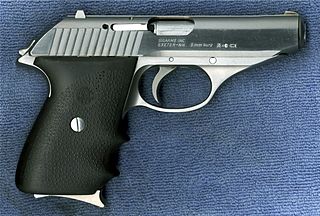
The SIG Sauer P230 is a small, semi-automatic handgun chambered in .32 ACP or .380 Auto. It was designed by SIG Sauer of Eckernförde, Germany. It was imported into the United States by SIGARMS in 1985. In 1996 it was replaced by the model P232.

The 1931 Fabrique Nationale (FN) Baby Browning is a small blowback-operated semi-automatic pistol designed by Belgium-born Dieudonné Saive chambered in .25 ACP. The pistol features a six-round magazine capacity and is a striker-fired, single action, blow back mechanism. The manual thumb operated safety locks the slide in the closed position when engaged using side thumb pressure.
Chiappa Firearms, Armi Sport di Chiappa, is an Italian firearms manufacturing company based in Brescia. It was founded in 1958 by Ezechiele Chiappa as Armi Sport. Total unit production is around 60,000 per year. Its U.S. headquarters are in Dayton, Ohio.
